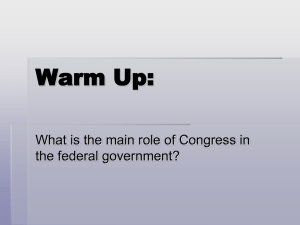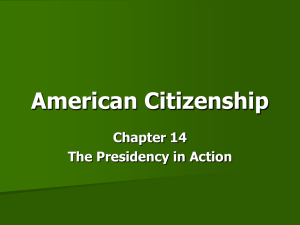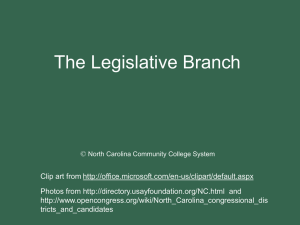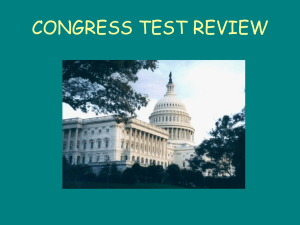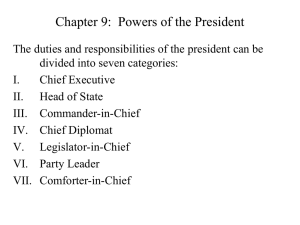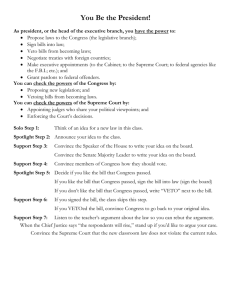Chp 8 Practice Test
advertisement
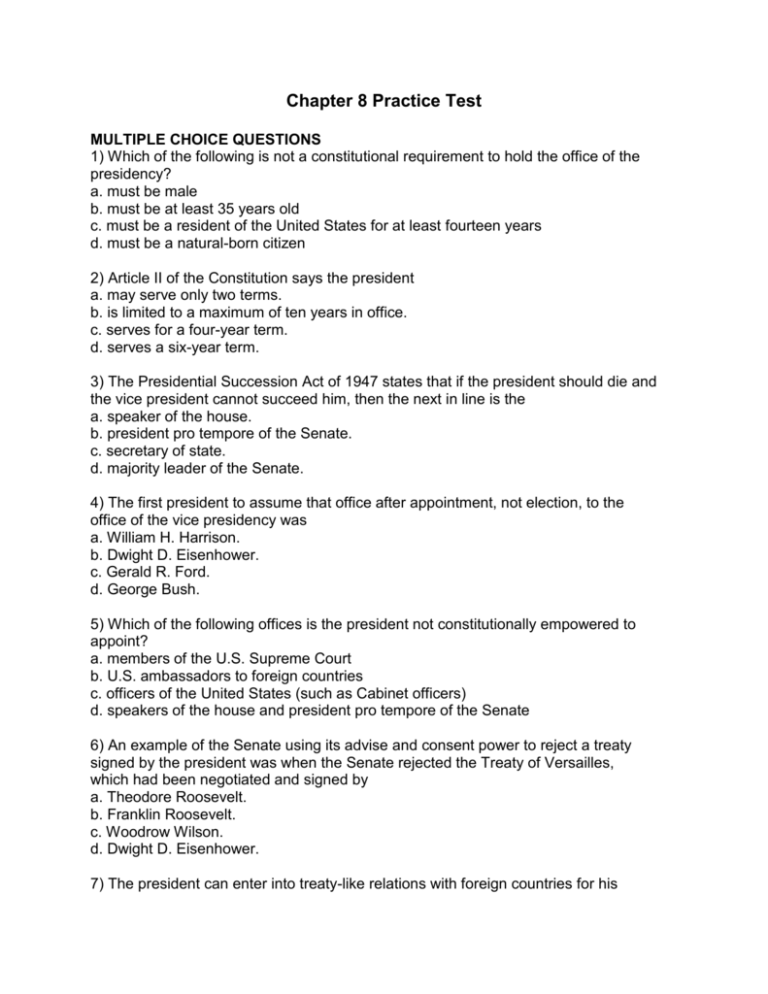
Chapter 8 Practice Test MULTIPLE CHOICE QUESTIONS 1) Which of the following is not a constitutional requirement to hold the office of the presidency? a. must be male b. must be at least 35 years old c. must be a resident of the United States for at least fourteen years d. must be a natural-born citizen 2) Article II of the Constitution says the president a. may serve only two terms. b. is limited to a maximum of ten years in office. c. serves for a four-year term. d. serves a six-year term. 3) The Presidential Succession Act of 1947 states that if the president should die and the vice president cannot succeed him, then the next in line is the a. speaker of the house. b. president pro tempore of the Senate. c. secretary of state. d. majority leader of the Senate. 4) The first president to assume that office after appointment, not election, to the office of the vice presidency was a. William H. Harrison. b. Dwight D. Eisenhower. c. Gerald R. Ford. d. George Bush. 5) Which of the following offices is the president not constitutionally empowered to appoint? a. members of the U.S. Supreme Court b. U.S. ambassadors to foreign countries c. officers of the United States (such as Cabinet officers) d. speakers of the house and president pro tempore of the Senate 6) An example of the Senate using its advise and consent power to reject a treaty signed by the president was when the Senate rejected the Treaty of Versailles, which had been negotiated and signed by a. Theodore Roosevelt. b. Franklin Roosevelt. c. Woodrow Wilson. d. Dwight D. Eisenhower. 7) The president can enter into treaty-like relations with foreign countries for his term only without Senate approval on the basis of a. executive powers. b. executive privilege. c. executive orders. d. executive agreements. 8) In 1996, Congress voted to give the president line-item veto power. What is the status of that power now? a. President Clinton refused to use it, claiming that the Republican Congress was attempting to trick him. b. The Congress voted to repeal the line-item veto given to the president saying that the president was trying to trick them. c. In 1998, the U.S. Supreme Court struck down the line-item veto as unconstitutional. d. The president continues to use the line-item veto and has done so over twenty times during the past year. 9) Thomas Jefferson expanded the powers of the presidency through a. the Louisiana Purchase. b. the use of veto powers. c. the use of political parties to cement ties with Congress. d. the doctrine of enumerated powers. 10) The first president who acted as a strong national leader was a. Thomas Jefferson. b. Andrew Jackson. c. James Monroe. d. Franklin D. Roosevelt. 11) The growth of the modern presidency began with a. Thomas Jefferson. b. Abraham Lincoln. c. Franklin Roosevelt. d. Ronald Reagan. 12) The most recent Cabinet department established was in 2002 and is the Department of a. Homeland Security b. Energy. c. Veteran's Affairs. d. Education. 13) The president most scholars consider to be the most effective in working with Congress, getting 60 percent of his programs through Congress, was a. Lyndon B. Johnson. b. Richard M. Nixon. c. Gerald R. Ford. d. Bill Clinton. 14) According to Richard Neustadt, the most important presidential power is a. his constitutional power. b. the mandate power. c. the power to persuade. d. his commander in chief power. 15) The term “bully pulpit” was used first by what president to describe the power of the president to reach out to the American people to gain support for his programs? a. Theodore Roosevelt b. Woodrow Wilson c. Franklin Roosevelt d. John F. Kennedy TRUE/FALSE QUESTIONS 1) Under the Articles of Confederation, no executive branch, and therefore no president of the United States, existed. 2) The president is limited to two terms in Article II of the Constitution. 3) In 1967, the Twenty-Fifth Amendment was added to the Constitution to allow a president to nominate a replacement to fill a vacancy in the office of vice president. 4) The first use of the Twenty-Fifth Amendment was when Gerald R. Ford appointed Nelson Rockefeller to be his vice president. 5) Article II gives the president power to appoint members of the congressional leadership, with the approval of the Senate. 6) The president's power to make treaties is limited by the requirement of a vote of two-thirds of the Senate to ratify the treaty. 7) The president has the power to reject all or part of any bill passed by Congress. 8) While only the Congress has the power to declare war, the president has the power to make and wage war. 9) Since the 1973 adoption of the War Powers Act by Congress, every president since Richard Nixon has vigorously supported the War Powers Act as a constitutionally permissible limit on his executive power. 10) Direct, personal appeals to the American people by the president, going over the heads of Congress via radio and television (called “going public”) effectively empowers the president to influence Congress.





